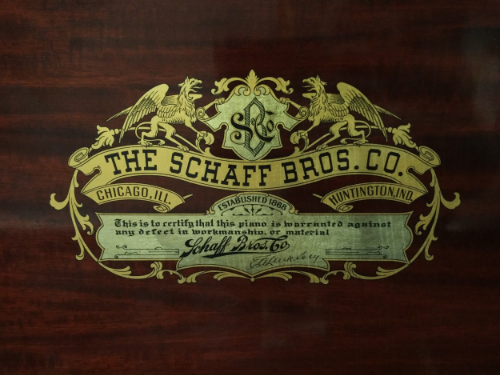By Nazrul Chowdhury, Hailey Gonzalez, Carol Huang, and Libby Norton, Binghamton University
When walking around downtown Binghamton, one would see what looks like a quiet, boring parking ramp next to a department store called “Boscov’s.” However, there is a story to be told about the sounds that can be heard at this location during the 1920s. This is possible through an Aural postcard which is listening to sound as a piece of history. There are many sounds that were popular and common then, becoming silent today and the ramp is a perfect example of that silence. What is now a parking ramp was once a thriving family business; creating and operating player pianos which provided a key source of entertainment to the families that owned them.
Close up of a Schaff Bros. Player Piano at Tech Works!, Image by Carol Huang
From 1914-1929, the Link Piano Company was owned by Edwin Link and family, who manufactured the Link Player Piano. His piano led to a cultural shift in the way people interacted with music, especially in social environments that involved music and dancing. In that generation, learning to play the piano was an expected role performed by women in the household. This shift, led by the Link Player Piano paved the way for music to be listened to in a new manner. Thus, the roles of women changed to adapt to the new technological advances and relieved them from being the sole entertainment for the family.
Player Piano With Roll at Tech Works!, Image by Libby Norton
During the era of silent films, music was provided by a live performer who played behind the scenes. With this technological shift, this role was no longer required. Thus, decreasing jobs with the advancing changes of technology. Another change was that the first player piano required someone to physically pump the pedals with their feet in order to create an airflow that will generate the sound. When air passes through the perforated music rolls, the air goes through the 88 pipes that are individually connected to 88 bellows.
Woman using Pedals on Player Piano, Tech Works!, ImAge by Libby Norton
Later, an automatic player piano was created which took away the physical pump. This piano worked in a similar fashion, but in order to listen to this piano, only a nickel is required in the appropriate slot.
Close up of the Bellows of an automatic Player Piano at Tech Works!, These bellows would lead to the development of the link flight simulator, Image by Libby Norton
Edwin Link and his family were a huge factor in the way that technology shifted and his legacy was continued by his son who created the flight simulator. At the time, Binghamton had become a city of innovation with technological advances such as the Bundy Time Clock and Mcintosh audio amplifier. It gradually rose as a city that had a lasting impression for its technological advancements. Despite being the birthplace for various technologies, the city began to modify itself to adapt to wartime. For example, Edwin Link Jr’s flight simulator played an integral role for the US Army by helping to train soldiers. But as the Cold War ended, the city began to see economic downturn as its defense related manufacturing declined and people were laid off.
Link Flight simulator at Tech Works!, Image by Carol Huang
Today, much of the city’s economy is generated through the University and its students. Many students are only here for four years to complete their studies, so interacting with the locals isn’t as commonplace as it should be. For most students, such as ourselves, the rich history of Binghamton goes neglected. As students who have walked countless times through downtown Binghamton, we have passed the parking ramp, but have never pondered at the thought of its rich history. But through our English class, “How We Listen” taught by Professor Jennifer Stoever, we learned about the impact of the sounds in the area, and how we can revive the sounds of the past to educate ourselves through these aural postcards.
Authors of this Aural Postcard Presenting their Research (L-R) Libby Norton, Hailey Gonzalez, Nazrul Chowdhury, and Carol Huang








